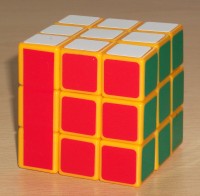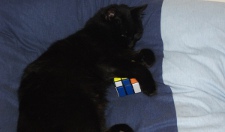Twisting Puzzles
Bandaged Cube (L-Block)

Bandaging a cube means sticking together some of the cubies. This creates some interesting sticker patterns and, because the number of faces that you can turn is restricted, the cube is quite tricky to solve.
This is a home-made version made from a cheap DIY glow-in-the-dark orange speed cube that I hadn't got around to stickering. I used sheets of vinyl from Cubesmith to make the two longer stickers. The result is quite pleasing despite the mistake I made with the arrangement of the colours (no need to let me know). I called it the L-block before I realised that it's the same as half of a Siamese Cubes puzzle. The approach to solving this should work on that puzzle too.
Bandaging up spare cubes like this is very easy to do and gives you a new puzzle at the end. Messing this one up isn't as tricky as it is on the Meffert's bandaged cube. When you do start to solve it though, it won't take long before you notice that one of your algorithms doesn't work because it would split up the bandaged block. Each bandaging pattern creates new characteristics for the puzzle. This one has two corners which are always held together - changing the corner orientation and positioning cases that can occur.
I solve this using a corners-first approach with the bandaged pieces on the top face. I used the ACube program by Josef Jelinek to search for algorithms to position and orient the corners using a restricted set of turns to avoid the bandage. For anyone interested in puzzles, how they work and how to solve them, I can whole-heartedly recommend this as an interesting activity at every stage.

